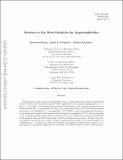| dc.contributor.author | Elvang, Henriette | |
| dc.contributor.author | Freedman, Daniel Z. | |
| dc.contributor.author | Kiermaier, Michael | |
| dc.date.accessioned | 2012-06-01T15:49:49Z | |
| dc.date.available | 2012-06-01T15:49:49Z | |
| dc.date.issued | 2010-10 | |
| dc.date.submitted | 2010-09 | |
| dc.identifier.issn | 1126-6708 | |
| dc.identifier.issn | 1029-8479 | |
| dc.identifier.uri | http://hdl.handle.net/1721.1/70983 | |
| dc.description.abstract | Supersymmetry and R-symmetry Ward identities relate on-shell amplitudes in a supersymmetric field theory. We solve these Ward identities for N [superscript K] MHV amplitudes of the maximally supersymmetric =4 and =8 theories. The resulting superamplitude is written in a new, manifestly supersymmetric and [subscript R]-invariant form: it is expressed as a sum of very simple SUSY and SUR -invariant Grassmann polynomials, each multiplied by a “basis amplitude”. For N [superscript K] MHV n-point superamplitudes the number of basis amplitudes is equal to the dimension of the irreducible representation of SU(n − 4) corresponding to the rectangular Young diagram with columns and K rows. The linearly independent amplitudes in this algebraic basis may still be functionally related by permutation of momenta. We show how cyclic and reflection symmetries can be used to obtain a smaller functional basis of color-ordered single-trace amplitudes in =4 gauge theory. We also analyze the more significant reduction that occurs in =8 supergravity because gravity amplitudes are not ordered. All results are valid at both tree and loop level. | en_US |
| dc.language.iso | en_US | |
| dc.publisher | Springer Science + Business Media B.V. | en_US |
| dc.relation.isversionof | http://dx.doi.org/10.1007/jhep10(2010)103 | en_US |
| dc.rights | Creative Commons Attribution-Noncommercial-Share Alike 3.0 | en_US |
| dc.rights.uri | http://creativecommons.org/licenses/by-nc-sa/3.0/ | en_US |
| dc.source | arXiv | en_US |
| dc.title | Solution to the Ward identities for superamplitudes | en_US |
| dc.type | Article | en_US |
| dc.identifier.citation | Elvang, Henriette, Daniel Z. Freedman, and Michael Kiermaier. “Solution to the Ward Identities for Superamplitudes.” Journal of High Energy Physics 2010.10 (2010): 1-34. | en_US |
| dc.contributor.department | Massachusetts Institute of Technology. Center for Theoretical Physics | en_US |
| dc.contributor.department | Massachusetts Institute of Technology. Department of Mathematics | en_US |
| dc.contributor.approver | Freedman, Daniel Z. | |
| dc.contributor.mitauthor | Freedman, Daniel Z. | |
| dc.relation.journal | Journal of High Energy Physics | en_US |
| dc.eprint.version | Author's final manuscript | en_US |
| dc.type.uri | http://purl.org/eprint/type/JournalArticle | en_US |
| eprint.status | http://purl.org/eprint/status/PeerReviewed | en_US |
| dspace.orderedauthors | Elvang, Henriette; Freedman, Daniel Z.; Kiermaier, Michael | en |
| dc.identifier.orcid | https://orcid.org/0000-0001-8408-1941 | |
| mit.license | OPEN_ACCESS_POLICY | en_US |
| mit.metadata.status | Complete | |
